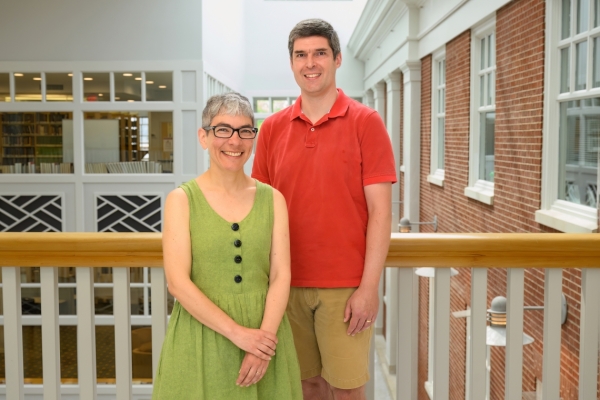W&L Professors and Students Co-Author Peer-Reviewed Paper on Web-Weaving Spiders Professors Nadia Ayoub and Kyle Friend, and students Jamal Magoti ’23, Maria Luzaran ’23, Cooper Lazo ’24 and Eman Muamar ’24 all contributed to the paper that appeared in the open science platform Frontiers.
Washington and Lee Professor of Biology Nadia Ayoub and Associate Professor of Chemistry and Biochemistry Kyle Friend recently co-authored a peer-reviewed paper featured in the open science platform Frontiers with support from several students at the university and colleagues at Virginia Tech and the American Museum of Natural History.
The paper, “Orb Weaver aggregate glue protein composition as a mechanism for rapid evolution of material properties,” was also co-authored by W&L students Jamal Magoti ’23, Maria Luzaran ’23 and Cooper Lazo ’24, with Eman Muamar ’24 providing data collection and analysis support.
The paper’s research was supported by a grant from the National Science Foundation and focuses on orb-weaving spiders in the superfamily Araneoidea, a group defined by the ability to synthesize aqueous glues in the special silk glands called aggregate glands. The team, especially W&L students, identified the aggregate proteins that allow spiders to construct sticky webs. The glue absorbs water from the atmosphere and needs to be optimized to achieve the best stickiness results for the local humidity. However, there are many species of orb weaver spiders living in different environments, which means their glue must adapt to different levels of humidity.
“Discovering the sticky protein components of biological glues opens the doors to determining how material properties evolve,” said Ayoub, who served as the project’s principal investigator. “Spider silk fibers and glues represent a fantastic model for answering such questions since they are primarily made of proteins and proteins are encoded by genes.”
To understand how spider glue stickiness adapts, the research group focused on two species, Argiope argentata, which lives in dry environments, and Argiope trifasciata, which lives in humid environments. The team collected webs from A. trifasciata in the wild and had A. argentata spiders build webs in the lab. To ensure that these webs were equivalent to webs in the wild, the scientists fed the spiders a diet comparable to their usual prey and compared glue droplet volume to wild controls to make sure that the humidity in the lab wasn’t affecting the droplets’ properties. They then analyzed the proteins in the glue and the droplets’ material properties.
“This study only examined two species, so our proposed relationships between proteins and material properties are limited,” cautioned Ayoub. “However, we are in the process of documenting protein components and material properties of a diverse set of species, which will allow more power to detect the mechanisms of how proteins give rise to material properties.”
Ayoub joined W&L’s faculty in 2009, following a post-doctoral fellowship through the National Institutes of Health at the University of California, Riverside. She received her bachelor’s degree from the University of Georgia and her doctorate from the University of Tennessee. Friend has been with the university since 2013 after he completed a postdoctoral fellowship at the University of Wisconsin. He holds a bachelor’s degree from The Ohio State University and a doctorate from Yale University.
If you know a W&L faculty member who has done great, accolade-worthy things, tell us about them! Nominate them for an accolade.
 Nadia Ayoub and Kyle Friend
Nadia Ayoub and Kyle Friend
You must be logged in to post a comment.